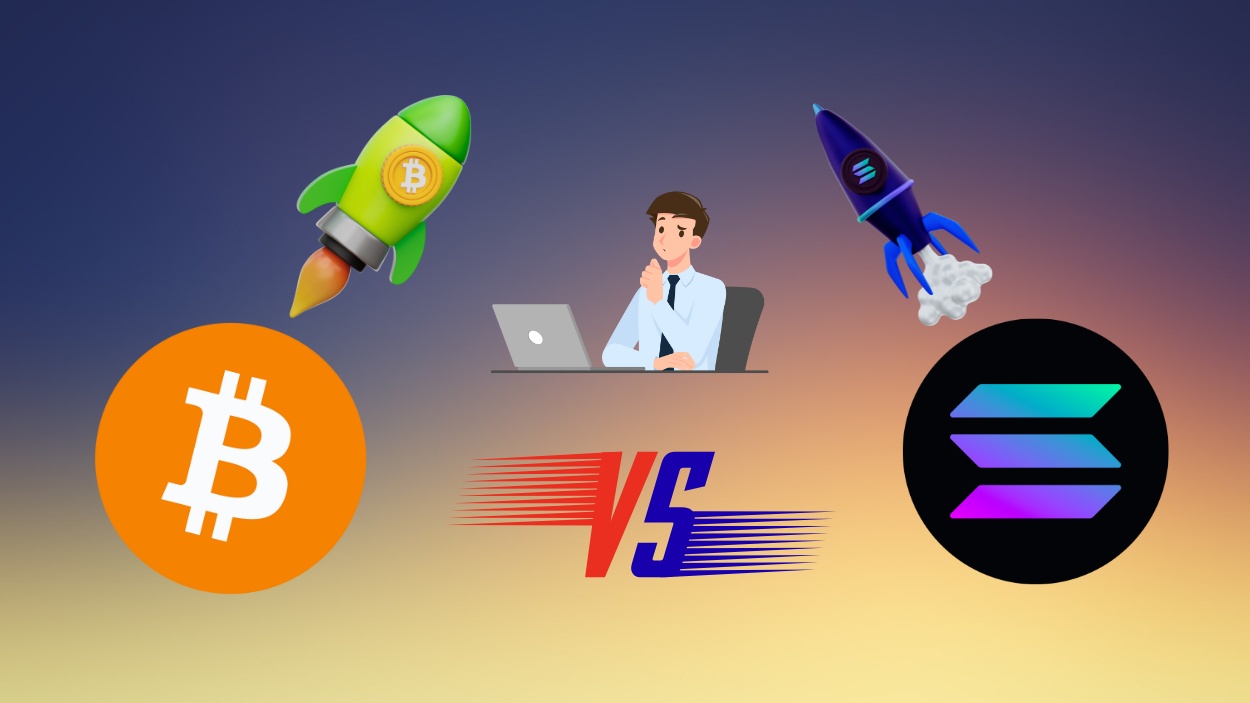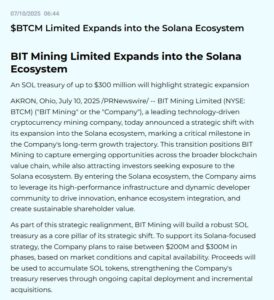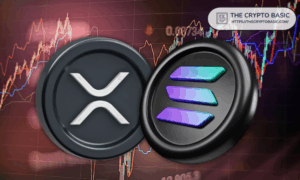CoinLaw: Market Cap Insights & Speed Trends Transforming Crypto Today

bitcoin vs. Solana: A Comprehensive Analysis of the Crypto Landscape in 2025
In the early stages of cryptocurrency, bitcoin was the sole player that captured attention. However, as we look ahead to 2025, the landscape has transformed significantly. While bitcoin continues to be the cornerstone of the decentralized movement, Solana has established itself as a formidable competitor, recognized for its speed and innovative features.
- Key Insights
- Blockchain Throughput: A Comparative Overview
- Market Capitalization Insights
- Transaction Speed and Throughput Analysis
- DEX Trading Volume Trends
- Energy Consumption and Environmental Impact
- Network Fees and Cost Efficiency
- Total Value Locked (TVL) Overview
- Adoption Rates and Wallet Statistics
- Developer Activity and Ecosystem Growth
- Net bitcoin Flows for Public Companies and ETFs
- Security and Downtime Incidents
- NFT and DeFi Usage Metrics
- MicroStrategy’s Dominance in Public bitcoin Holdings
- Institutional Investment Trends
- Social Media and Community Engagement
- Occupation Breakdown of Crypto Consumers
- Regulatory Developments and Legal Standing
- Price Volatility and Historical Performance
- Recent Developments
- Conclusion
The comparison between bitcoin and Solana is not merely about superiority; it revolves around their strengths in distinct areas. For investors, developers, or anyone interested in the crypto space, this article delves into the key metrics that define the market in 2025.
Key Insights
-
Market Capitalization: By 2025, bitcoin‘s market cap has reached $1.38 trillion, while Solana has climbed to $82.1 billion, marking its ascent into the upper echelon of blockchain networks.
-
Transaction Processing: Solana boasts an impressive capacity of around 65,000 transactions per second, far exceeding bitcoin‘s average of 7 TPS.
-
Transaction Fees: bitcoin‘s average transaction fee has surged to $17.34, in stark contrast to Solana’s minimal fee of just $0.00025.
-
Active Wallets: Solana has surpassed 35 million active wallets, while bitcoin‘s count is nearing 50 million.
Blockchain Throughput: A Comparative Overview
- ethereum: Handles only 0.08 transactions per unit, making it one of the least scalable options.
- Polygon: Slightly better at 0.1, showing modest improvements over ethereum.
- ethereum 2.0: Increases throughput to 1.3, reflecting gradual advancements.
- Celestia: Slightly outpaces ethereum 2.0 with 1.4, indicating early adoption potential for modular blockchains.
- Avail: Reaches 6.4, showcasing enhanced capabilities in data availability-focused chains.
- EigenLayer: Supports 15 transactions, marking a significant leap in scalability.
- Next-Gen Blockchains: Sui, Aptos, and others achieve 100, demonstrating the promise of new architectures.
- Solana: Achieves 125, ranking among the top general-purpose blockchains for throughput.
- Solana: Firedancer: Leads with an astounding 1,250, making it over ten times faster than standard Solana.
Market Capitalization Insights
- bitcoin‘s total market cap in 2025 stands at approximately $1.38 trillion, maintaining its leading position in the crypto market.
- Solana’s market cap has risen to $82.1 billion, making it the 5th largest cryptocurrency.
- bitcoin‘s market dominance has slightly decreased from 52% in 2024 to 48.9% in 2025 due to increased competition.
- Solana’s share of the total crypto market cap has grown from 2.1% in 2024 to 2.9% in 2025.
- Year-over-year, Solana’s market cap has increased by 56%, while bitcoin‘s growth is more modest at 14%.
- bitcoin ETFs under management have reached $72 billion, contributing to its market stability.
- Solana’s Total Value Locked (TVL) in DeFi has hit $17.4 billion, enhancing its valuation and financial applications.
- Daily trading volume for bitcoin averages $45 billion, while Solana sees about $5.9 billion.
- bitcoin‘s fully diluted valuation exceeds $1.7 trillion, while Solana’s is just under $93 billion.
- Both cryptocurrencies are listed on over 300 exchanges, but Solana enjoys greater diversity in token pairings due to its cross-chain capabilities.
Transaction Speed and Throughput Analysis
- Solana processes 65,000 TPS in 2025, compared to bitcoin‘s 7 TPS, thanks to their differing architectures.
- The average confirmation time on Solana is just 400 milliseconds, while bitcoin takes about 10 minutes.
- Solana’s daily transaction volume has surpassed 30 million, while bitcoin manages around 340,000.
- In stress tests, Solana achieved a peak throughput of 94,000 TPS without significant failures.
- The bitcoin Lightning Network has improved throughput slightly but still maxes out at 1,000 TPS and lacks widespread adoption.
- Finality on Solana is achieved within 2 seconds, whereas bitcoin‘s probabilistic finality remains around 60 minutes.
- Solana’s block time is 400ms, while bitcoin maintains a fixed 10-minute interval.
- Transaction batching and Layer 2 scaling solutions allow bitcoin to enhance throughput, albeit with added complexity.
- Solana supports parallel transaction execution through Sealevel, enhancing throughput for smart contract-heavy operations.
- bitcoin‘s mempool congestion in Q1 2025 increased average wait times to over 25 minutes during peak periods.
DEX Trading Volume Trends
- Total DEX trading volume peaked at $358 billion in January 2025, marking the highest monthly activity across all chains.
- High volumes were also recorded in November and December 2024, with $269 billion and $285 billion, respectively.
- Solana and ethereum consistently captured significant market shares in DEX volume during this period.
- Layer 2 solutions like Arbitrum and Base contributed steadily, reflecting their growing importance.
- Smaller chains like THORChain, Avalanche, and Sui maintained minor yet stable shares, indicating niche utility.
- After January’s peak, trading volumes fell to $224 billion in February and further to $159 billion in March, suggesting a market cooldown.
- The lowest trading volume was recorded in October 2024, totaling $138 billion, before a rapid recovery in subsequent months.
Energy Consumption and Environmental Impact
- bitcoin‘s energy consumption in 2025 is approximately 141 TWh per year, comparable to that of a mid-sized nation.
- In contrast, Solana consumes only 0.0023 TWh annually, a fraction of bitcoin‘s footprint due to its Proof-of-History and Proof-of-Stake design.
- The energy required for a single bitcoin transaction is estimated at 707 kWh, while Solana’s is just 0.0019 kWh.
- bitcoin‘s carbon emissions reached 73 million metric tons CO₂ equivalent annually in 2025.
- Solana’s emissions are estimated to be under 50,000 metric tons CO₂e.
- Solana has achieved carbon neutrality through offset programs and improved validator efficiency.
- Over 57% of bitcoin mining now utilizes renewable energy sources.
- Solana validators primarily operate in eco-efficient data centers, with green staking incentives introduced in Q2 2025.
- The bitcoin Mining Council reports a 17% decrease in fossil fuel reliance among major operations.
- The Solana Foundation’s Green Paper 2025 outlines a commitment to net-zero emissions by 2027, positioning it as a leader in sustainable crypto practices.
Network Fees and Cost Efficiency
- Solana’s average transaction fee in 2025 remains below $0.00025, making it ideal for microtransactions and high-frequency applications.
- Conversely, bitcoin‘s average transaction fee has risen to $17.34, largely due to network congestion and the use of Ordinals.
- The cost per million transactions on Solana is under $250, while bitcoin‘s exceeds $17 million.
- Fee volatility on bitcoin has increased by 24% year-over-year, particularly during peak network activity.
- The Lightning Network has helped alleviate fee pressure on bitcoin, but only 22% of active wallets utilize it consistently.
- Over 97% of Solana transactions cost less than $0.001, making it highly cost-effective for developers and decentralized applications.
- The average NFT minting fee on Solana is around $0.04, compared to $45 to $85 for bitcoin‘s Ordinals.
- Token transfers on Solana cost mere cents, while bitcoin token layer transfers can run into the hundreds of dollars.
- Solana’s gas optimizations in 2025 have reduced costs by 12% following Sealevel upgrades.
- bitcoin transaction batching offers some savings for exchanges, but costs still scale linearly with usage.
Total Value Locked (TVL) Overview
- ethereum leads the ecosystem with 56.8% of total value locked (TVL), underscoring its dominance in DeFi.
- Solana holds 7.03%, maintaining a strong position among Layer 1 chains.
- Tron follows closely with 6.54%, reflecting its active user base and stablecoin activity.
- Binance Smart Chain (BSC) accounts for 4.35%, serving as a cost-effective DeFi alternative.
- Coinbase’s Layer 2, Base, captures 2.92%, indicating rapid growth and adoption.
- bitcoin contributes 2.87% to TVL, despite not being a native smart contract platform.
- Arbitrum secures 2.53%, reinforcing its role as a scalable ethereum Layer 2.
- Other blockchains like Avalanche, Sui, and Aptos hold 1.21%, 1.14%, 1.1%, and 0.9%, respectively, showing moderate but promising adoption.
- The remaining blockchains are grouped as “Others,” collectively making up 12.6%, representing a fragmented long tail of niche networks.
Adoption Rates and Wallet Statistics
- bitcoin‘s active wallets in 2025 are around 50 million, while Solana has surpassed 35 million.
- Solana wallet creation has grown by 44% year-over-year, while bitcoin‘s growth has slowed to 9%.
- Mobile wallet usage is prevalent, with 72% of Solana users accessing the network through mobile-first applications like Phantom or Solflare.
- bitcoin leads in hardware wallet adoption, with over 11 million users utilizing devices like Ledger and Trezor.
- Adoption of Solana Pay has surged by 56%, with integrations in platforms like Shopify, Discord, and TikTok-native merchants.
- The number of bitcoin ATMs worldwide has exceeded 43,000, providing retail access points globally.
- Solana ecosystem wallets, such as Phantom, have introduced biometric authentication and in-app staking in 2025.
- bitcoin wallets with multi-signature enabled now represent 31% of custodial addresses.
- Solana-based web wallets have gained traction, with 34% of users preferring browser extensions.
- bitcoin‘s address reuse rate remains a privacy concern, with 17.8% of daily transactions involving previously used addresses.
Developer Activity and Ecosystem Growth
- Solana is leading in developer growth, boasting over 17,000 monthly active developers in Q2 2025, surpassing ethereum in certain sectors.
- bitcoin has around 1,000 active core developers, primarily focused on bitcoin Core and Lightning upgrades.
- Solana Hackathons in 2025 have generated over 800 new projects, including those in DePIN, DeFi, and gaming.
- bitcoin development is concentrated, with 93% of contributions directed towards the Core protocol and a few side ecosystems.
- Over $100 million in grants were distributed by the Solana Foundation in the first half of 2025.
- Solana Foundation GitHub repositories saw +38% commit growth, compared to +6% for bitcoin Core.
- bitcoin Improvement Proposals (BIPs) have only increased by 7 this year, indicating slower protocol evolution.
- Developer retention on Solana stands at 62%, signaling ecosystem maturity and satisfaction.
- Solana’s modular smart contract tools, such as Anchor and Seahorse, have improved development speed by 25% in 2025.
- bitcoin‘s scripting language remains non-Turing complete, limiting programmability compared to Solana’s Rust-based smart contracts.
Net bitcoin Flows for Public Companies and ETFs
- In Q2 2025, public companies saw an 18% increase in bitcoin holdings, while ETFs rose by 8%.
- In Q1 2025, public companies increased holdings by 17.6%, compared to a modest 0.5% gain for ETFs.
- Q4 2024 recorded the highest spike, with public companies gaining 66% and ETFs up by 17%.
- The overall trend shows stronger growth in public company holdings compared to ETFs throughout the four quarters.
Security and Downtime Incidents
- bitcoin has maintained a perfect uptime record of 100% since 2013, with no protocol-level failures reported in 2025.
- Solana experienced a minor outage in Q1 2025 lasting 18 minutes, down from three major incidents in 2022.
- Solana has implemented local fee markets and validator client diversity in 2025 to mitigate single-point failures.
- bitcoin‘s hashrate peaked at 540 EH/s in 2025, marking an all-time high and enhancing network security.
- Solana validators now exceed 3,200 globally, with 34% hosted on independent data centers.
- bitcoin‘s transaction finality is slower but more secure due to its proof-of-work consensus and deep block confirmations.
- Solana’s switch to multiple validator clients has reduced the risk of coordinated failures by 63%.
- bitcoin nodes number over 18,000 active public full nodes, ensuring decentralization and verification redundancy.
- Solana’s average block propagation time is now under 0.3 seconds, minimizing orphaned blocks and forks.
- No critical vulnerabilities were reported in bitcoin Core this year; Solana resolved three moderate ones without user impact.
NFT and DeFi Usage Metrics
- Solana hosts over 28 million NFTs, with daily trading volumes averaging $13.2 million.
- The bitcoin Ordinals protocol recorded over 55 million inscriptions by mid-2025, but only 3% are actively traded.
- Solana’s DeFi TVL in 2025 is $17.4 billion, led by platforms like Jito, MarginFi, and Drift.
- bitcoin‘s DeFi TVL (via RSK and Stacks) remains under $350 million, reflecting limited adoption.
- Solana NFT marketplaces like Tensor and Magic Eden handle over 60% of all cross-chain NFT trades.
- The average minting fee for NFTs on Solana is approximately $0.04, making it appealing for independent creators.
- NFT trading volume on bitcoin declined by 17% in Q1 2025 after the initial excitement around Ordinals waned.
- Solana’s compressed NFTs allow creators to mint over 10,000 assets for under $100, revolutionizing gaming and digital art.
- bitcoin lacks a native NFT infrastructure, relying on unconventional inscription techniques.
- Solana NFT holders number 2.1 million unique addresses, surpassing all chains except ethereum.
MicroStrategy’s Dominance in Public bitcoin Holdings
- MicroStrategy holds a staggering 65.6% of all bitcoin owned by publicly traded companies, reinforcing its position as the leading corporate BTC holder.
- The remaining market, including all other public companies combined, holds only 34.4%, highlighting the concentration of BTC holdings in a single entity.
- This dominance underscores MicroStrategy’s aggressive accumulation strategy and long-term bullish outlook on bitcoin.
Institutional Investment Trends
- bitcoin remains the leading institutional asset, with over $72 billion in ETF assets under management globally.
- Solana’s institutional exposure has rapidly increased, totaling $4.9 billion across hedge funds, trusts, and ETFs.
- BlackRock’s bitcoin ETF accounts for $19.6 billion in assets under management, launched in late 2024.
- VanEck and 21Shares launched Solana ETFs in Q1 2025, attracting $870 million in inflows within three months.
- Over 65% of institutional crypto portfolios include bitcoin, compared to 18% that now include Solana.
- MicroStrategy’s bitcoin holdings have increased to 254,300 BTC, valued at over $16 billion in 2025.
- Solana has seen a threefold increase in venture funding for infrastructure startups, surpassing $1.2 billion YTD.
- Fidelity’s digital assets unit began offering Solana staking for institutional clients in March 2025.
- Grayscale’s Solana Trust (GSOL) trades at a 5.3% premium, indicating rising demand.
- Institutional staking yield on Solana averages 6.5%, while bitcoin remains non-yielding unless tokenized or lent.
Social Media and Community Engagement
- bitcoin leads in follower count, boasting over 6.3 million Twitter/X followers on its main foundation accounts.
- Solana’s community engagement rate is higher, averaging 4.7% interaction per post, compared to bitcoin‘s 1.8%.
- Solana Discord communities total over 1.8 million active users across ecosystem channels.
- Reddit’s r/bitcoin has reached 4.9 million members, remaining the most subscribed crypto subreddit.
- Solana-themed YouTube content has seen a 53% increase in uploads in the first half of 2025.
- Top Solana influencers now drive 8-10 million monthly impressions, fueled by gaming and NFT content.
- bitcoin‘s Google search volume has declined by 7% year-over-year, while Solana’s has increased by 34%.
- Solana Hackathon livestreams attracted over 400,000 viewers globally across platforms in May 2025.
- TikTok creators under the #Solana tag have accumulated over 1.1 billion views, surpassing #BitcoinNFT for the first time.
- GitHub watch/star metrics for Solana development tools have increased by +38% YoY, indicating developer-led growth.
Occupation Breakdown of Crypto Consumers
- Self-employed individuals lead the crypto space, making up 29.3% of users, highlighting strong adoption among freelancers and independent workers.
- Employed professionals follow closely at 28.3%, indicating significant interest from those in traditional jobs.
- Students represent 20.7%, showcasing a growing presence of young and tech-savvy users.
- Entrepreneurs and investors account for 13.5%, reflecting crypto’s appeal to risk-tolerant individuals.
- Unemployed users make up 6.9%, suggesting limited but notable engagement from those outside the workforce.
- Only 1.4% of crypto consumers are retired, indicating minimal traction among older demographics.
Regulatory Developments and Legal Standing
- bitcoin received formal classification as a “digital commodity” by the US CFTC in early 2025.
- Solana was declared a “non-security” under the SEC’s updated Framework for Crypto Assets Guidance.
- The EU’s MiCA regulation, effective January 2025, lists both bitcoin and Solana as compliant under Tier 1 frameworks.
- bitcoin ETFs were approved in Japan and South Korea, while Solana-based ETPs launched in Switzerland and Singapore.
- The IRS now requires detailed staking disclosures; Solana stakers must report yield above $600 annually.
- China continues to restrict bitcoin trading, while Solana developers operate from Hong Kong SAR under fintech exemptions.
- New York State’s revised BitLicense explicitly names Solana as a “low-risk protocol” due to validator transparency.
- bitcoin mining was banned in two additional Indian states in 2025 due to energy strain during heat waves.
- Solana was added to the UK FCA’s whitelist, enabling retail promotion under the new financial promotions regime.
- Canada’s OSC approved Solana-focused retail funds, allowing exposure within TFSA/RRSP accounts.
Price Volatility and Historical Performance
- bitcoin‘s average annualized volatility in 2025 has dropped to 41%.
- Solana’s volatility remains higher at 62%, though it has decreased from 87% in 2022.
- bitcoin reached an all-time high of $89,400 in April 2025, marking a 23% increase year-over-year.
- Solana peaked at $218 in June 2025, representing a 62% increase from its 2024 high.
- bitcoin‘s drawdown from its ATH in July 2025 was -7.8%, while Solana’s was -13.2%.
- The 30-day correlation between bitcoin and Solana fluctuated between 0.59 to 0.74, indicating moderate alignment.
- Solana had 11 green months out of the past 15, compared to bitcoin‘s 9 in the same timeframe.
- bitcoin‘s realized cap crossed $525 billion, while Solana’s surpassed $38 billion, indicating a significant gap, though narrowing.
- Solana-based options volume on Aevo and Zeta increased by +48% in Q2, reflecting growing trader interest.
- bitcoin‘s dominance metric dropped below 50% for the first time since 2021, attributed to altcoin performance.
Recent Developments
- Solana launched the Firedancer testnet v2, with mainnet deployment expected in Q3 2025 to enhance validator diversity.
- bitcoin Core 26.0 introduced Schnorr signature refinements and experimental Drivechains, eliciting mixed reactions.
- Solana integrated zk compression for scalable NFTs, enabling on-chain gaming at 80% less cost.
- Ark Invest rebalanced its fund, reducing bitcoin from 60% to 48% to increase Solana and ethereum weight.
- bitcoin‘s halving in April 2024 reduced miner rewards to 3.125 BTC, impacting profitability and price forecasts.
- Solana Mobile Saga 2 launched in May, selling 160,000 units in Q2, boosting mobile dApp adoption.
- bitcoin‘s transaction fees briefly exceeded block rewards in May, driven by high Ordinals traffic.
- Solana’s validator expansion program added 1,100 new validators, improving decentralization metrics.
- USDC adoption on Solana surpassed $3.8 billion in circulating supply, pushing it past ethereum for stablecoin transaction count.
Conclusion
bitcoin and Solana have each established distinct roles within the blockchain ecosystem. bitcoin offers unparalleled security, decentralization, and institutional support, while Solana delivers speed, scalability, and cost-effectiveness for next-generation applications.
In 2025, the choice between the two is not a simple one; bitcoin serves as the foundation, while Solana represents the frontier. Whether you aim to hedge, build, or speculate, grasping their fundamental differences is crucial. The data speaks volumes, and in the world of crypto, numbers are the true guiding force.







